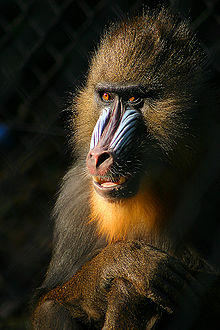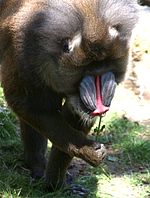- Mandrill
-
This article is about the primate. For other uses, see Mandrill (disambiguation).
Mandrill[1] 
Conservation status Scientific classification Kingdom: Animalia Phylum: Chordata Class: Mammalia Order: Primates Family: Cercopithecidae Genus: Mandrillus Species: M. sphinx Binomial name Mandrillus sphinx
(Linnaeus, 1758)
Mandrill range The mandrill (Mandrillus sphinx) is a primate of the Old World monkey (Cercopithecidae) family,[3] closely related to the baboons and even more closely to the drill. Both the mandrill and the drill were once classified as baboons in genus Papio, but recent research has determined they should be separated into their own genus, Mandrillus.[3] The mandrill is the world's largest species of monkey. Charles Darwin wrote, "no other member in the whole class of mammals is coloured in so extraordinary a manner as the adult male mandrills".[4]
Contents
Description
The mandrill is perhaps the most colorful primate. It has an olive green or dark grey pelage with yellow and black bands and a white belly. Its hairless face has an elongated muzzle with distinctive characteristics such as a red stripe down the middle and protruding blue ridges on the sides. It also has red nostrils and lips, a yellow beard and white tuffs. The areas around the genitals and the anus are multi-colored, being colored red, pink, blue, scarlet, and purple.[5] They also have pale pink ischial callosities.[5] The coloration of the animal is more pronounced in dominant adult males. Both sexes have a patch of skin, surrounded by bristly hairs, on their chests that are used in olfactory communication. These, too, are more pronounced in dominant adult males.[6] Males also have longer canines than females, with an average of 4.5 cm (1.8 in) and 1.0 cm, respectively.[7]
Males average 25–35 kg (55-77 lb), females are less than half that weight (11–14 kg, or 25-30 lb). Unusually large males can weigh 50 kg (110 lb).[8][9][10] The average male is 81–90 cm (32–36 in) and the female is 56–66 cm (22–26 in), with the tail adding another 5–8 cm (2–3 in).[11][12] They can survive up to 31 years in captivity. Females reach sexual maturity at about 3.5 years. The mandrill has one of the greatest sexual dimorphisms among the primates.
Ecology and activities
The mandrill is found in southern Cameroon, Gabon, Equatorial Guinea, and Congo. Its distribution is bounded by the Sanaga River to the north and the Ogooué and White rivers to the east. Recent research suggests that mandrill populations north and south of the Ogooué river are so genetically different as to be separate subspecies. Mandrills prefer to live in tropical rainforests and forest-savanna mosaics. They also live in gallery forests with savanna areas, riparian forests, rocky forests, agricultural areas and inundated forests and stream beds.[13][14] Mandrills will cross grass areas within their forest habitat.[15][16]
The mandrill has an omnivorous diet. It mostly consumes plant matter and consumes over hundred species of plant. It mostly eats fruit, but will also eat leaves, lianas, bark, stems and fibers. It also consumes mushrooms and soil.[14] With animals, mandrills mostly eat invertebrates, particularly ants, beetles, termites, crickets, spiders, snails and scorpions. It will also eat eggs, and occasionally vertebrates such as birds, tortoises, frogs, porcupines, rats and shrews.[14] Mandrills likely will eat larger vertebrates, such as juvenile bay duikers and small antelope.[17] One study found that the Mandrill’s diet was composed of fruit (50.7%), seeds (26.0%), leaves (8.2%), pith (6.8%), flowers (2.7%), and animal foods (4.1%), with other foods making up the remaining (1.4%).[18] Mandrills themselves are preyed on by leopards, crowned eagles and certain snake species.[15]
While mandrills are mostly terrestrial, they are more arboreal than baboons, and have been found in all forest levels.[5][7] When on the ground, mandrills walk by digitigrade quadrupedalism. When in the trees, they move by lateral jumps.[13] Mandrills are mostly diurnal, with activities starting in the morning and continuing into the evening.[19] At night they sleep in trees. They sleep at a different site each night.[14] In the wild and in captivity mandrills have been observed using sticks to clean themselves. [2] [3]
Social behavior and reproduction
Mandrills seem to live in large stable groups called "hordes". Hordes often number in the hundreds, possibly averaging around 620 individuals and reaching as many as 845.[13][15][16] It is difficult to accurately estimate group size in the forest, but filming a group crossing a gap between two forest patches or crossing a road is a reliable way of estimating group size. The largest group verifiably observed in this way contained over 1300 individuals, in Lopé National Park, Gabon — the largest aggregation of non-human primates ever recorded.[20] Year-round residents of these groups are adult females and their dependent offspring.[21] Males live a solitary lifestyle, and only enter hordes during female seasonal sexual cycling, which last three months each year.[15][21] In addition to hordes and solitary males, smaller groups of 50 individuals have been recorded, though rarely, but never all-male bachelor groups.[15][21]
The mating season of the mandrill takes place from June to October, which is when sexual swellings occur.[21] They breed every two years. When breeding, a male will follow and guard a female in estrus. Adult males exist in two different forms; the brightly colored and "fatted" dominant males and the paler and "non-fatted" subordinate males. Both males exchange in mating, but only the dominant males are able to sire offspring.[16] Gaining dominance results in an increase testicular volume, reddening of sexual skin on the face and genitalia and heightened secretion of the sternal cutaneous gland.[22] When a male loses dominance, the reverse happens, although the blue ridges remain brightened. When subordinates mate guard a female, the competition between them allows the dominant males to have a greater chance of siring offspring[23] since subordinates outnumber dominates 21 to 1. There is also a dominance hierarchy among females, with reproductive success being displayed in shorter interbirth intervals amongst these alpha figures and the beginning of reproduction at earlier ages.[23]
Mandrill births occur from January to May.[24] Most births in Gabon occur in the wet season, from January to March, and gestation usually lasts 175 days.[23] The inter-birth intervals last 405 days.[23] Young are born with a black natal coat and pink skin. The females do most of the raising of the young. Alloparenting exists in this species, with aunts, sisters and cousins providing care for the young. This allows females to obtain necessary food resources and defend against predation.[25] Males leave their natal groups when they are six years old and become peripheral to the social group.[15][21]
Mandrills will make a "silent bared-teeth face", where it exposes its teeth by curling back the lips, erects the crest of the head, while shaking the head. This has a peaceful function.[26][27] A mandrill submits by presenting the rump. With aggression, mandrills will stare, bob their heads and slap the ground.[27] Long distance calls that are made include the roars, crowings and "two-phase grunts", while short distance calls that are made include "yaks", grunts, "k-alarms", "k-sounds", screams, girneys, and grinds.[28]
Status and conservation
The mandrill is considered vulnerable,[2] and is affected by the destruction of its evergreen forest habitat, since this reduces the capacity of environments to support mandrill populations. However, the most immediate threat is posed by hunting for their meat (which is highly prized in Gabon). Commercial bushmeat hunters pose a particular threat to populations which are located close to main roads and towns. Mandrills appear to be most seriously threatened in Congo (Brazzaville).[2] Nevertheless, there have been captive-bred individuals that have been successfully reintroduced into the wild.[29]
References
- ^ Groves, C. (2005). Wilson, D. E., & Reeder, D. M, eds. ed. Mammal Species of the World (3rd ed.). Baltimore: Johns Hopkins University Press. pp. 165. OCLC 62265494. ISBN 0-801-88221-4. http://www.bucknell.edu/msw3/browse.asp?id=12100576.
- ^ a b c Oates, J. F. & Butynski, T. M. (2008). Mandrillus sphinx. In: IUCN 2008. IUCN Red List of Threatened Species. Downloaded on 4 January 2009.
- ^ a b Nowak, Ronald M (1999), Primates of the World, Baltimore, Maryland: The Johns Hopkins University Press, pp. 151–152, ISBN 0-8018-6251-5, http://books.google.com/books?id=unODoWa7CM4C&printsec=frontcover&dq=%22Walker's+Primates+%22#v=onepage&q&f=false, retrieved 7 September 2010
- ^ Darwin, Charles (1871). The Descent of Man, and selection in relation to sex.. D. Appleton and Co, New York.
- ^ a b c Ankel-Simons F. (2007) Primate Anatomy: an introduction, 3rd Edition. San Diego: Elsevier Acad Pr. 724 p.
- ^ Feistner ATC. (1991) "Scent marking in mandrills, Mandrillus sphinx". Folia Primatol 57(1):42-7
- ^ a b Leigh SR, Setchell JM, Charpentier M, Knapp LA, Wickings EJ. (2008) "Canine tooth size and fitness in male mandrills (Mandrillus sphinx) ". J Hum Evol 55(1):75-85.
- ^ WAZA - World Association of Zoos and Aquariums - Virtual Zoo
- ^ http://www.answers.com/topic/mandrill-2
- ^ http://www.springerlink.com/content/h43033656767l10u/
- ^ http://www.sandiegozoo.org/animalbytes/t-mandrill.html
- ^ http://animals.nationalgeographic.com/animals/mammals/mandrill.html
- ^ a b c Sabater Pí J. (1972) "Contribution to the ecology of Mandrillus sphinx Linnaeus 1758 of Rio Muni (Republic of Equatorial Guinea) ". Folia Primatol 17:304-19.
- ^ a b c d Hoshino J. (1985) "Feeding ecology of mandrills (Mandrillus sphinx) in Campo Animal Reserve, Cameroon". Primates 26(3):248-73.
- ^ a b c d e f Harrison MJS. (1988) "The mandrill in Gabon's rain forest-ecology, distribution and status". Oryx 22(4):218-28.
- ^ a b c Rogers, M. E., Abernethy, K.A., Fontaine, B., Wickings, E.J., White, L.J.T and Tutin, C.E.G. (1996). "Ten Days in the Life of a Mandrill Horde in the Lopé Reserve, Gabon." Am J Primatol 40: 297-313.
- ^ Kudo H, Mitani M. (1985) "New record of predatory behavior by the mandrill in Cameroon". Primates 26(2):161-7.
- ^ Tutin CEG, Ham RM, White LJT, Harrison MJS. (1997). "The primate community of the Lopé Reserve, Gabon: diets, responses to fruit scarcity, and effects on biomass". Am J Primatol 42(1):1-24.
- ^ Jouventin P. (1975) "Observations sur la socio-ecologie du mandrill". Terre et la Vie 29:493-532.
- ^ [1]
- ^ a b c d e Abernethy KA, White LJT, Wickings EJ. (2002) "Hordes of mandrills (Mandrillus sphinx): extreme group size and seasonal male presence". J Zool (Lond.) 258(1):131-7.
- ^ Setchell, J. M., and Dixson A.F. (2001) "Changes in the Secondary Sexual Adornments of Male Mandrills (Mandrillus sphinx) Are Associated with Gain and Loss of Alpha Status." Hormones and Behavior 39(3): 177-184.
- ^ a b c d Setchell, J. M., and Dixson A.F. (2002) "Developmental Variables and Dominance Rank in Adolescent Male Mandrills (Mandrillus sphinx)." Am J Primatol 56: 9-25.
- ^ Wickings, E. J., and Dixson, A.F. (1992). "Development from birth to sexual maturity in a semi-free-ranging colony of mandrills (Mandrillus sphinx) in Gabon." Journal of Reproduction and Fertility 95(1): 139-144.
- ^ Charpentier, M., Peignot, P., Hossaert-Mckey, M., Gimenez, O., Setchell, J.M. and Wickings, E.J. (2005). "Constraints on control: factors influencing reproductive success in male mandrills (Mandrillus sphinx)." Behavioral Ecology 16(3): 614-623.
- ^ Bout N, Thierry B. (2005) "Peaceful meaning for the silent bared-teeth displays of mandrills". Int J Primatol 26(6):1215-28.
- ^ a b Setchell JM, Wickings EJ. (2005) "Dominance, status signals and coloration in male mandrills (Mandrillus sphinx) ". Ethology 111(1):25-50.
- ^ Kudo H. (1987) "The study of vocal communication of wild mandrills in Cameroon in relation to their social structure". Primates 28(3):289-308.
- ^ Peignot P, Charpentier MJE, Bout N, Bourry O, Massima U, Dosimont O, Terramorsi R, WIckings EJ. (2008) "Learning from the first release project of captive-bred mandrills Mandrillus sphinx in Gabon". Oryx 32(1):122-31.
External links
- ARKive - images and movies of the mandrill (Mandrillus sphinx)
- Primate Factsheet - Drill Primate Info Net
Categories:- IUCN Red List vulnerable species
- Mammals of Africa
- Megafauna of Africa
- Cercopithecine monkeys
- Animals described in 1758
- Tool-using species
Wikimedia Foundation. 2010.




